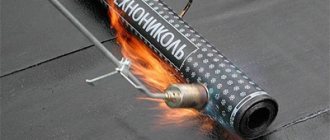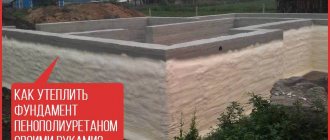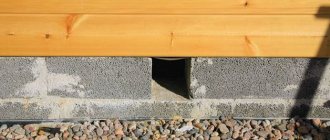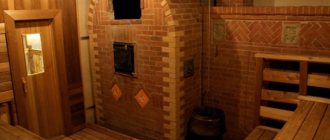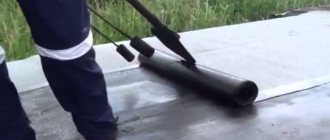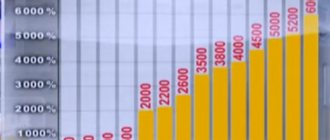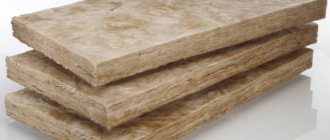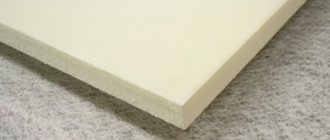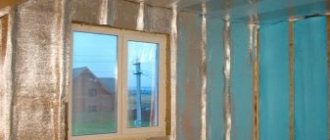When constructing a building, it is necessary to carefully consider the waterproofing of the foundation and plinth. The service life of the object depends on the quality of the work performed. The performed operation will protect the base of the object from the effects of groundwater. There are several methods of protection:
- installation of a drainage system;
- use of insulation.
A special material is often used - TechnoNIKOL foundation waterproofing. It is in demand due to its good performance characteristics.
Types of foundation waterproofing work
In accordance with the purpose of the construction project, the following is produced:
- Anti-filtration insulation for the construction of complex structures and large loads on the base. And also if the soil of the construction site has excess moisture. The work being carried out is a complicated process that requires special preparation.
- Anti-corrosion insulation, which requires less effort, is easier to perform. It is divided into horizontal (protects against capillary drawing in of water) and vertical (lateral protection) waterproofing.
There are several finishing methods:
- Plastering - done with a solution of cement and mineral components. The thickness of the protective layer is no more than 21 millimeters.
- Pasting - made using waterproof material. The thickness is no more than 5 millimeters.
- Coating - performed using a waterproof coating. The working layer is no more than 3 millimeters.
Waterproofing technology depending on the type of foundation
Each type of building support requires certain protection options. Before waterproofing the foundation, you need to find out what is required for the full range of measures.
Strip foundation protection
Waterproofing of strip foundations differs for monolithic and prefabricated versions. First, let's look at the prefabricated version. To prevent damage to the underground walls of the house and flooding of the basement, the following measures will be required:
- installation of a reinforced seam between factory-made foundation slabs and concrete blocks of the basement walls;
- laying rolled material in the first seam between the blocks, which is located below the basement floor level;
- the rolled material is mounted along the edge of the foundation at the junction of the walls and the supporting structure;
- vertical insulation of the underground part of the tape from the outside;
- blind area device.
Belt protection
It is important to note that at the junction of foundation slabs and concrete blocks, materials based on bitumen binder cannot be laid. This can lead to displacement of elements relative to each other
Here, only a thickened concrete joint is suitable. Insulation along the edge of the foundation is necessary so that different moisture content of the material of the supporting parts of the building and wall fences does not lead to destruction. For horizontal insulation, pasting methods are used.
Vertical insulation is best done from the outside, since this will not only protect the room, but also the load-bearing elements. During new construction, walls can be treated with pasting or coating materials. Repair work is being carried out from the inside. In this case, the penetrating or injection type is used.
If you need to carry out a set of waterproofing works for a monolithic tape, then it is worth considering the following measures:
- vertical insulation;
- waterproofing along the edge of the foundation;
- blind area device.
Materials are selected in the same way as for the prefabricated version.
Protection of columnar and pile foundations
A simple method of moisture protection
The simplest type of moisture protection is used here. You only need to make insulation along the edge of the foundation. Its location depends on the material of the grillage. If the piping is made of the same material as the foundation, then the roll materials are laid at the point of contact between the grillage and the walls. You may want to consider another option. For example, a wooden house rests on metal piles. In this case, the lower crown of the walls will serve as a grillage, so the insulating layer is laid on the heads of the supporting elements.
Foundation slab protection
To protect against moisture, the following measures will need to be taken:
- concrete preparation from lean concrete to protect the slab from underground water and leveling the base;
- waterproofing for concrete preparation;
- protection from external moisture.
Waterproofing of the foundation slab
To produce the second layer when constructing a slab, roll methods are used. It is best to focus on modern materials, since after pouring the slab, it is almost impossible to monitor the condition of such insulation or carry out repairs. For small buildings with a low degree of responsibility and low water saturation of the soil, polyethylene film is often used.
To protect the slab from moisture that may enter from above, it must be treated with penetrating compounds. Sometimes in private housing construction they resort to using the following method: a solution for penetrating insulation is introduced into the concrete composition.
Before you properly waterproof the foundation (slab strips, piles, pillars), you need to carefully study the issue
It is important to use high-quality materials. If you save at this stage of construction, you can spend a large amount of money on repairs during operation
Source
Product range
produces several types of products, differing in structure and method of application:
- Pasted waterproofing is available in roll form. The basis is a polymer with a self-adhesive coating. The material is due to its low cost. Used for finishing the base from the outside. And also for gluing floors in the basement of a building.
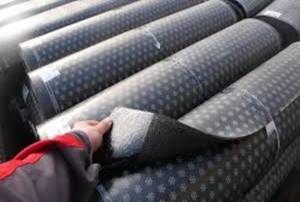
- Coating waterproofing is made on the basis of mastics with the addition of various components. The working solution is used hot or cold.
TechnoNIKOL products with high performance indicators can be purchased at reasonable prices.
The choice of building material is determined by operational requirements and practicality.
Prices for installation of roll waterproofing
Below is a table with prices for devices of various types of waterproofing. When specifying prices and the price per 1 m2, standard indicators of the complexity of the work, as well as materials of average quality, were taken into account.
If you want to find out exact prices and receive a detailed estimate indicating current prices for all items, then you can write to us by email or call the phone number indicated in the contacts.
| Name of works | Unit _ | Price in Rubles |
| Installation of built-up waterproofing on the horizon in 1 layer | m2 | 360 |
| Installation of built-up waterproofing on the vertical in 1 layer | m2 | 490 |
| Installation of a self-adhesive membrane on the horizon in 1 layer | m2 | 350 |
| Installation of a self-adhesive membrane on a vertical in 1 layer | m2 | 480 |
| Installation of PVC membrane on the horizon in 1 layer | m2 | 580 |
| Installation of PVC membrane vertically in 1 layer | m2 | 680 |
| Application of bitumen primer | m2 | 100 |
Calculator for independently calculating the cost of waterproofing
Open calculator
Waterproofing cost calculation
Areas of application
TechnoNIKOL products for foundations are used to protect the zero cycle of a construction project from the destructive effects of groundwater. All products comply with regulatory requirements and GOSTs. Technical indicators characterize the quality of protective insulation:
- waterproof;
- heat resistance;
- water absorption;
- resistance to mechanical damage.
The products are used in several directions:
- Waterproofing in rolls is a reliable protection for the foundation and plinth of a building.
- Bitumen, mastic (coating material) for preparatory work. Used to cover monolithic structures that are located underground.
- The membrane is used for installation of drainage systems.
Foundation membrane
TechnoNIKOL produces a profiled waterproofing membrane for foundations under the name PLANTER. It is made of extruded polyethylene, on the surface of which hollow round projections 8 mm high are molded in a checkerboard pattern. The canvas evenly distributes point loads over the surface of the foundation and does not interfere with air exchange.
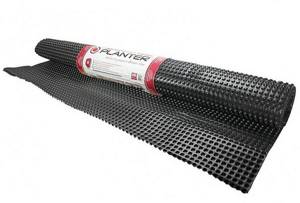
TechnoNIKOL profiled membrane for foundation waterproofing
The PLANTER membrane is used as protection:
- waterproofing against mechanical damage;
- the outer surface of underground structures from groundwater;
- insulating materials from aggressive substances, deformation during soil movements, plant roots;
- walls of basements and basements from dampness.
In drainage systems, a membrane is used to drain water from the foundation walls, which flows between the projections into pipes laid around the perimeter of the building. PLANTER canvas can be used to replace a concrete pad when constructing a preparatory layer for foundations. At the same time, the problem of water drainage is solved.
Roll insulation group
The material is divided into self-adhesive and built-up waterproofing for foundations. offers construction products:
- Alpha - the base is aluminum foil and polyester. The polymer film forms a reliable coating. Prevents the ingress of water and the passage of radioactive and explosive gases.
- The barrier is made with a self-adhesive layer. Used for work outside and inside buildings.
- Barrier-Light – the top layer is made of non-woven polypropylene. To work with the material, the air temperature must be at least +5 degrees.
- Technoelastmost is a weld-on insulation group that does not change under heavy load. Used for horizontal protection of foundations.
- EPP – laid by horizontal and vertical fusion. Withstands loads up to 0.2 MPa.

TechnoNIKOL foundation waterproofing is superior in performance indicators to roofing felt. A wide range of products allows you to choose the required material.
Useful tips
Recommendations from experienced builders will help you avoid mistakes when doing the work yourself:
- in order not to make a mistake when choosing a material for waterproofing, you need to take into account the level of groundwater and the climate of the region;
- in areas with heavy rainfall, multi-layer protection from coating and roll insulation will be the best;
- to prevent capillary moisture from seeping from the foundation into the walls of the building, it is necessary to lay a layer of cut-off waterproofing between them;
- for reliability, it is advisable to protect not only the foundation walls outside and inside, but also the base underneath;
- Insulating the foundation with extruded polystyrene foam will reduce heating costs and protect the waterproofing from mechanical damage.
Compared to other manufacturers, Technonikol products have the best price/quality ratio. The company has a network of stores throughout Russia that guarantee delivery of materials within 24 hours.
Coating insulation group
TechnoNIKOL offers products for foundation coating operations. The working composition differs in the temperature at which the process is performed.
The hot application mastic is heated to a temperature of 180 degrees. The composition creates a protective layer and reliably fills cracks in the base. Penetrates deeply into the surface being treated.
Cold application mastic includes several components. When mixing the working solution, an activator is added. For better adhesion, the surface of the foundation is coated with a primer.
TechnoNIKOL No. 21 and No. 24 (bitumen and bitumen-polymer mastics) allows you to carry out work at temperatures from -20 to +40 degrees. The material is applied using a roller, brush or pouring method with leveling. After drying, a protective film against water is formed. The solution is completely ready for use and does not form joints. The consumption of TechnoNIKOL No. 24 is 1 kilogram per square meter.
Using coating waterproofing, a reliable protective layer from moisture is obtained. The coating has the same performance over the entire base area.
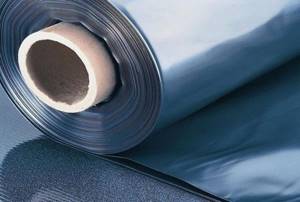
Step-by-Step Guide to Foundation Insulation
In order to take into account the nuances of foundation waterproofing with TechnoNIKOL materials, before starting work, you must familiarize yourself with the Guidelines issued by the corporation.
The manufacturer's instructions contain many questions related to the installation of waterproofing insulators, including:

features of the use of bitumen-polymer membranes;- features of various methods of laying insulators;
- characteristics of bitumen-polymer membranes;
- material storage conditions.
- surface preparation, priming.
Membrane insulation coating
If the groundwater level is high, a drainage structure is installed on the construction site. TechnoNIKOL produces a special membrane PLANTER. The basis of the material is a high-density polymer. One side of the membrane has rounded spikes.
Waterproofing is installed on the side surface of the base. The foundation is first primed with a special compound. Then a layer of waterproofing material (roll or mastic) is applied. And only then is the membrane installed, with rounded spikes facing outwards.
When the groundwater level rises, the liquid flows over the membrane coating into the pipe system.
Membrane waterproofing can withstand temperatures down to -50 degrees, the strength is 455 Newton. The membrane provides air ventilation.
Installation instructions
Depending on what type of floor the craftsman is dealing with, the waterproofing can be installed by gluing, fusing or laying.
The first method is suitable for all types of floors. Fused fusion is used for concrete floor surfaces, while decking is used for wood floors.
Before starting work, the most appropriate solution is to completely remove the old coating, and it is advisable to clear everything (down to the concrete base). This is followed by careful removal of debris, accumulations of dust and dirt and repair of all existing chips and cracks.
Existing protrusions and irregularities are removed with a grinder. The concrete floor is leveled with a building mixture and dried for 24 hours, after which its surface is sanded with coarse sandpaper.
If waterproofing is laid on a wooden floor, you should make sure that all boards are intact and that there are no creaks or sagging of the floors. If necessary, make the necessary repairs to the wooden floor before installing the waterproofing, for example by replacing individual floorboards.
Before starting the main work, the joints between the floor and the walls are rounded off using cement mortar to ensure a more even laying of the insulating material and to avoid kinks. After waiting for the final setting of the cement mixture and drying of the room, a primer is applied to the floor twice, and the junctions of the walls and floor are treated with a moisture-resistant compound or artificial rubber tape.
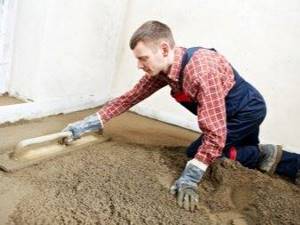
Before laying the waterproofing material, the material is kept indoors for at least 24 hours. The roll must be unrolled or cut into pieces along the length of the room. The fastening of the waterproofing coating with “flooring” should be done so that its individual parts overlap one another with an overlap of 20-25 cm. Upon completion of installation, the material is fixed using self-tapping screws or pressed against floor boards.
Installation of rolled weld-on waterproofing will be carried out using a propane gas burner to create a temperature of 1450-1600 degrees. With its help, the bottom layer of material is melted and fixed to the floor surface. It should be taken into account that if the flame temperature deviates from the recommended flame temperature in one direction or another, peeling of the insulating coating may occur.

The adhesive method of laying waterproofing consists of applying bitumen-polymer mastic or glue to the floor base. These substances must be heated to a temperature of 25-250 degrees.
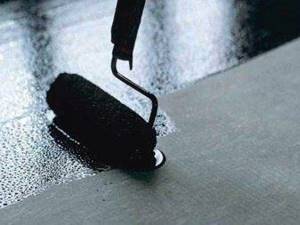
If an adhesive layer has already been applied to the coating, then there is no need to pre-treat it with mastic. Upon completion of installation, all areas where the sheets of waterproofing material join together are coated with glue, and the surface of the waterproofing material is rolled with a pressure roller.
In order to more reliably protect the floor from moisture, it is recommended to lay the insulating material in two layers perpendicular to each other. After the coating has hardened, existing defects (irregularities or air bubbles) are eliminated and construction of a concrete screed, laying ceramic tiles or other coating begins.
Laying of TechnoNIKOL self-adhesive rolled floor waterproofing should be done at a room temperature of more than +10°C.
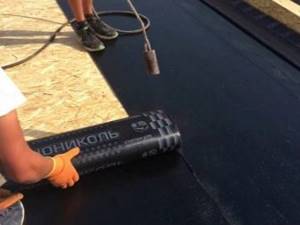
After this, the material, which is laid with longitudinal overlaps of about 80-100 mm, is glued and pressed. In this case, about 150 mm is allocated for the end overlaps. Overlapping areas are coated with bitumen mastic, the layer thickness of which is about 1 mm. On vertical surfaces, the material should be brought to the required height.
The TechnoNIKOL brand ensures the development of new models of roll waterproofing for use in various climatic conditions and taking into account the production needs of the consumer. Baseless self-adhesive roll waterproofing coatings for floors and foundations are widely used. In addition to protection from moisture, waterproofing coatings produced by TechnoNIKOL can protect premises from noise, dust and the penetration of gaseous substances.
To learn how to install TenoNICOL floor waterproofing, see the following video.
Advantages and disadvantages
All products have advantages and disadvantages. To perform various construction operations, a certain material is selected:
- To waterproof a building with a complex structure, a bitumen mixture is selected.
- Cold laid insulation is recommended for use in basements.
- Roll material allows for quick installation. Ideal for large areas of uncomplicated structures.
- Mastic must be selected for each construction operation.
Thanks to waterproofing, you can increase the usable area of the house. The basement can be used as a living space, and not for storing unnecessary things.
Types of moisture insulation
Materials in this area allow for several classifications. We are talking about time and places of application, names, purpose and arrangement. Each variety has its own characteristics and characteristics.
Horizontal waterproofing
The main purpose is to prevent moisture from moving from one level to another.
Compatible with all types of foundations:
- tape;
- slab;
- in the form of separate supports.
Most often it involves the use of rolled types of materials, including:
- polymer emulsions, with injection;
- bitumen mastic. Refers to universal compositions;
- technoelast. Additionally provides protection against mold damage;
- hydroglass insulation With high moisture resistance. Bitumen waterproofing of the foundation can also boast of it;
- hydroisol – sheet welding materials;
- roofing felt is durable and affordable.
Vertical waterproofing
Such protection is relevant for buildings both underground and above it. It is expected that internal and external surfaces will be treated with special compounds.
In particular, we are talking about the following decisions:
- biocides. Their prices vary;
- antiseptics;
- hydrophobic materials;
- pasted types of insulation, needed in some situations;
- paint, plaster and coating materials.
The disadvantage of many materials is that they can only be used under certain weather conditions. Otherwise the foundation is destroyed.
Blind area device
The blind area is considered one of the comprehensive methods of protecting a home from all kinds of negative manifestations of the environment. This name is used for coating around the perimeter of the house, which provides additional protection. It becomes a water barrier, making staying indoors more comfortable
Therefore, a competent device is important
Of the existing varieties, the following have become the most popular:
- concrete;
- asphalt concrete;
- from a ceramic plate;
- from paving slabs;
- with gravel or natural stone.
The advantages also deserve special consideration:
- attractive appearance;
- waterproofing the blind area near the foundation;
- easy execution of work;
- reducing the overall height of the base;
- foundation insulation;
- reliability;
- maintainability;
- creating a continuous coating that ensures reliability.
Drainage
It is installed around the blind area when the following circumstances arise:
- the presence of a path made of non-monolithic materials;
- deepening the foundation below the freezing level;
- too high groundwater suitable for a monolithic structure;
- clay soil or heaving soil on which construction was carried out;
- the location of the building is low.
Some drainage systems are difficult to install, for example closed ones. But this option outperforms others in terms of efficiency and service life.
Features of waterproofing
To perform the work correctly, the following aspects must be taken into account:
- type of soil;
- depth of groundwater:
- swelling of the soil after frost;
- the load inherent in the project on the foundation.
Based on the analysis, a special installation technology is provided:
- When groundwater passes at a level of 1 meter from the lowest point of the foundation, coating protection is carried out with a combination of horizontal placement of TechnoNIKOL foundation roll waterproofing.
- If groundwater passes higher and does not reach the basement, the roll is installed in two layers and coated with mastic. Vertical protection is performed with adhesive material.
- When groundwater is located high, waterproofing is carried out inside and outside the building.
- The metal parts used in the work are treated with an anti-corrosion agent.
- Wooden structures are coated with an antiseptic composition.

In what cases is vertical waterproofing necessary?
Water of various origins can have a negative impact on the foundation:
- ground or soil moisture retained in the ground by capillary and adhesive forces. It is constantly present in the soil and does not depend on filtration or groundwater;
- seeping water resulting from rain and melting snow. When it gets into the ground, it fills the pores in the soil and, under the weight of its weight, penetrates into the deeper layers of the earth;
- underground water. The depth of its surface layer is the groundwater level, depending on the terrain.
When concrete comes into contact with any of the listed types of water, calcium hydroxide is washed out, as a result of which the porosity of concrete increases and its strength decreases, and since the presence of groundwater, filtration and underground waters is observed everywhere on our territory, it is impossible to do without waterproofing.
Not only the part of the foundation located in the ground needs vertical waterproofing, but also the part that is located above ground level. The reason is that water evaporates from the open pores of the above-ground surface of the foundation, forming a humidity gradient. As a result: water, rising up through the capillaries, absorbs moisture from the soil containing salt solutions. As it evaporates, it leaves salts that crystallize in the pores of the concrete, violating the integrity of its outer layer.
Additional insulation
The heat loss of a house is 10 percent if the base is not insulated. The structure is subject to harsh environmental influences. TechnoNIKOL foundation insulation has:
- resistance to mechanical stress;
- minimal water absorption;
- frost resistance;
- low vapor absorption rate.
Insulation made from extruded polystyrene foam and polyurethane foam has these properties and is suitable for installation outside the house.
Polyurethane foam fits tightly to the surface of the base, is highly resistant to aggressive environments, and does not form joints. There are also no “cold bridges”.
The materials differ not only in performance characteristics, but also in prices. Insulation made from extruded polystyrene foam is much more expensive.
Roofing felt waterproofing
One of the most popular building materials used for waterproofing is roofing felt. To glue it to the foundation, special mastics are used, which can be either hot or cold. Hot mastics are made on the basis of hot bitumen with the addition of additional components that impart high performance properties to the bitumen composition. To apply hot mastic, it is necessary to maintain a certain temperature (about 85 degrees Celsius) so that it retains its liquid consistency and fills all cracks on the protected surface well. Working with hot mastic requires special care and compliance with safety rules to prevent burns. Cold mastics are immediately ready for use without additional heating. They are sold in buckets. But the price for cold mastic is higher than for hot one.
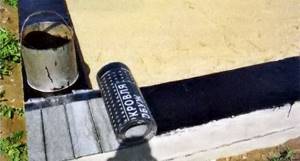
Before gluing the roofing felt, the surface is thoroughly cleaned of debris, and then treated with a primer that improves adhesion. After this, mastic is applied with a brush, rolling out a roll of roofing felt, which is leveled and pressed against the surface to be glued to ensure reliable contact. The edges of the rolls are glued overlapping by 10-15 cm to avoid gaps in the waterproofing coating. How to make horizontal waterproofing from roofing felt in a private house you can watch in this video:
https://youtube.com/watch?v=WP39XxDeDw4
Carrying out waterproofing work
Before performing construction operations with waterproofing material, it is necessary to prepare the surface. The process consists of performing the following points:
- A visual inspection of the surface is carried out. The base of an old building may have cracks and chips.
- Old waterproofing or paint is removed.
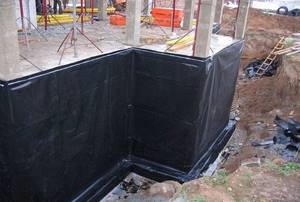
- Surface defects are repaired. To improve adhesion, the foundation is coated with a primer composition.
- Humidity control is carried out in the premises of the facility. Measurements are made with a moisture meter.
It is recommended to carry out work in dry weather. If there is a need to carry out a construction operation in winter, then you need to choose a certain material. Pay attention to the temperature regime.
Waterproofing is an important part of the work carried out during the construction of a facility. The process will help protect the building from the effects of groundwater and increase its service life.
Work technology
Do-it-yourself waterproofing should begin with preparing the base. Required:
- Cut off the protruding ends of the reinforcement, clean the protrusions so that the waterproofing material is not damaged by contact with solid particles of moving soil;
- Remove all dirt and dust using a stiff brush;
- Remove rust, paint and other coatings with a solvent, as... they reduce adhesion;
- Fill all potholes, chips, and cracks with cement;
- Fill the seams with sealant;
- Treat the base surfaces with a primer - a special bitumen primer.
Regardless of the type of TechnoNIKOL waterproofing material used, the installation technology has no fundamental differences:
- The mastic is first thoroughly stirred until smooth. The surfaces are cleaned of dirt, dust and the insulator is applied with a spatula, brush, or any other spraying method.
- Some types of waterproofing agents are applied to wet surfaces, others only to dry ones. Detailed instructions are indicated on the can of material or on paper that is attached to the rolls.
- TechnoNIKOL roll materials are laid overlapping to cover the joints.
- The bitumen layer is heated using safe electric heating equipment. Carefully heat the end of the material to securely attach it to the previous layer.
- A less safe way is to heat using an open flame of a gas burner. The installation speed will increase.
- Bitumen emulsion primers are used as independent waterproofing or as a primer before installing roll insulators. The protective properties will be better.
- The drying speed of the primer is no more than 50-60 minutes. Apply with a roller or brush.
Bitumen mastic can be diluted with white spirit, kerosene, and low-octane gasoline. Technoizol should not be used near open fire or in areas with poor ventilation. During the installation process, personal protective equipment is used.
Brands, composition and application of Technoelast
Below we discuss in detail the technical characteristics and scope of use of various modifications of the roll material.
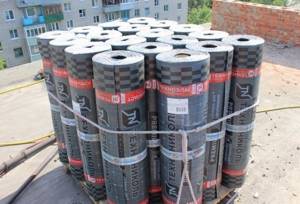
Technoelast HPP
Technoelast XPP can be used as waterproofing of construction sites and vapor barrier of soft roofs. The material retains its physical, technical and operational characteristics over a wide temperature range.
The HPP modification is a compressed fiberglass coated on both sides with modified bitumen with SBS polymer additives. The protective film, which serves as an indicator during fusing, prevents the web from sticking together in the roll.
Technoelast EPP
The reinforcing basis for Technoelast EPP is high-quality polyester. As a protective coating, a low-melting polymer film with a heating indicator is applied on both sides.
The material is used as the bottom layer of waterproofing of flat bitumen roofs of new buildings, because It is characterized by sufficient strength and elasticity, which allows it to compensate for shrinkage deformations. In addition, the EPP modification is used for waterproofing foundations, plinths, basements, etc.
Technoelast TKP
This modification of Technoelast is the most common. The basis is fiberglass, characterized by high strength characteristics and affordable cost. Coarse-grained mineral coating is used as a decorative and protective layer, which reliably protects the material from ultraviolet radiation, mechanical damage, chemical, biological and atmospheric influences.
The material is used for fusing the top layer of two-layer waterproofing of flat roofs of established buildings, as well as as the only layer of waterproofing of flat roofs during major renovations
Technoelast EKP
A reinforcing layer of polyester fiber allows the material to deform without changing the strength characteristics, integrity of the waterproofing layer and the protective and decorative layer of coarse shale chips.
These unique properties make it possible to use Technoelast EKP as the top layer of two-layer waterproofing for flat roofs of new buildings of any size. In addition, the material can be used as a single layer for major repairs and waterproofing of flat roofs
Technoelast Acoustic
It is used as a hydro- and sound-proofing layer in building structures, including when constructing floating floors. Significantly reduces impact noise exposure (by 21–26 dB).

The basis of Technoelast “Acoustic” is soundproof fiberglass, onto which a modified bitumen-polymer layer is applied. The canvases are laid end-to-end (the soundproofing layer is on the base side), taking into account the height of the finishing coating, and then secured with tape.
Solo
Technoelast “Solo” has a wide range of colors. Coarse-grained mineral coating is used as a protective and decorative layer; the lower part is a non-woven fabric. Used as waterproofing and when installing a single-layer roofing carpet. The material is indispensable in cases where simple mechanical fixation or laying on a layer of mastic is required.
Important! Can be fixed to the base using partial fusion. It has improved fire-fighting characteristics and is a moderately flammable material that practically does not spread flame.
Mini
Technoelast Mini EPP differs from its standard counterpart in having a smaller web width. To modify the bitumen-polymer binder, special SBS polymers and functional additives are introduced into it. The material is characterized by versatility, strength, elasticity and durability. It is used as a vapor barrier layer for fused roofs and waterproofing of various building structures.
Technoelast S
The reinforcing basis of Technoelast “S” EMS is a high-strength biostable polyester fabric impregnated on both sides with a bitumen-polymer binder composition. A low-melting polymer film is used as a coating.
Prime
What distinguishes Technoelast Prime EMM from other modifications is the possibility of without fire installation. The reinforcing base is a high-quality polyester fabric, onto which a bitumen-polymer binder composition is applied on both sides, which includes fillers, modified styrene-butadiene thermoplastic elastomer and other functional additives.
Decor
Technoelast "Decor" is produced by applying bitumen on a reinforcing base (cross-reinforced polyester) on both sides - a polymer binder composition consisting of bitumen, SBS (styrene-butadiene-styrene) polymer modifier and mineral fillers (talc, dolomite, etc.). Both sides of the canvas have a protective coating: a coarse-grained basalt coating on top and a polymer fusible film on the welded side.
Titanium
Technoelast "Titan" is produced by applying a binder bitumen-polymer mixture consisting of bitumen, APP (atactic polypropylene), IPP (isotactic polypropylene) polymer modifier and mineral fillers (talc, dolomite, etc.) on a non-woven polyester fabric on both sides, followed by application protective layers on both sides of the fabric. Coarse-grained, fine-grained (sand) coatings and polymer coatings can be used as protective layers.
Thermo
Technoelast "Thermo" is a multifunctional, APP-modified bitumen-polymer built-up roofing and waterproofing material of increased reliability. It is used for roofing buildings and structures, waterproofing foundations, bridges, tunnels and other building structures that require high reliability of waterproofing.
Green
Technoelast "Green" is resistant to damage by plant roots. It has chemical and mechanical protection against germination. The material is produced by double-sided impregnation of a polyester base with a bitumen-polymer binder consisting of bitumen, SBS (styrene-butadiene-styrene) polymer modifier, mineral filler (talc, dolomite, etc.) and anti-root additives. After this, protective coatings are applied to both sides of the canvas. Coarse-grained, fine-grained powders and polymer films are used as protective coatings.

